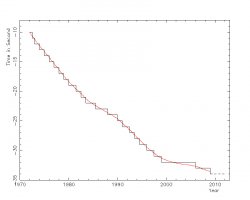
The rotation of the Earth, which produces day and night, is irregular and also slows down gradually in the course of time. In the long term, the tidal effect of the Sun and Moon dissipates its rotational energy. On shorter time scales, random variations are induced by atmospheric motions, by seasonal changes in the polar ice caps, by movements in the terrestrial core itself, and by seismic effects. This rotation, measured with respect to a fixed reference frame defined by the quasars and including a number of corrections, defines Universal time UT1, the modern extension of Greenwich Mean Time GMT, now obsolete.
Since 1967, the second is no longer defined by the motion of the sky, but is obtained using the properties of matter. In effect, a given atomic energy transition always corresponds to the same radiation frequency. That is how the second was defined in the international system of units2.
A part of the Service international de la rotation terrestre et des systèmes de référence - IERS (International Earth Rotation and Reference Systems), housed at the Observatoire de Paris within the SYRTE, measures changes in the rotation of the Earth and is thus responsible for the prediction and announcement of the leap second.

This decision is then implemented by the national and international authorities responsible for time distribution. In France, the LNE-SYRTE4 has this function. This other part of the SYRTE creates the Universal Coordinated Time (Temps Universel Coordonné)3 of the Observatoire de Paris - UTC(OP). This extremely accurate standard is used by the speaking clock run by the telephone operator Orange, housed at the Observatoire de Paris, to distribute civil time in France ; you can listen to it by dialling 36 99. Civil time based on UTC(OP) is also encoded on the carrier wave of France Inter and so is distributed in a transparent manner ; it can thus be accessed at any time by laboratories, by industry, by local authorities ... anywhere in metropolitan France5.
Research into ever greater precision is motivated not only by very practical applications such as the GPS, but also by theoretical research in fundamental physics and astronomy. The latest generations of clocks, developed at the SYRTE, use laser cooled strontium atoms, and will soon attain an accuracy of 10-17 for the clock frequency, or in other words an error of one second after 3 billion years !
Today, the continuation of the leap second is under discussion. It is not completely clear how to integrate it into information systems, since it is rare and unpredictable (following 2005 and 2008, this will be only the third leap second added since 1999). Since 1972, 24 leap seconds have been introduced, without any serious incident.
Other than a quarter of an hour difference after 500 years, the most spectacular consequence of its suppression would be that, for the first time in the history of humanity, time measurement would become completely independent of the motion of the stars in the sky.
Its fate will be decided at the next world radiocommunications conference organized by the UIT - Union Internationale des Télécommunications. Rendez-vous in 2015, give or take a few seconds.

Notes
- The SYRTE is a scientific department of the Observatoire de Paris and a "unité mixte de recherche" spanning the Observatoire de Paris, the CNRS and the Pierre and Marie Curie University.
- Until 1956, the second was defined as the 86 400th part of a mean solar day of the year 1900. Today, it is defined as being equal to 9 192 631 770 periods of the radiation which corresponds to the transition between two hyperfine levels in the ground state of an atom of caesium 133.
- The Bureau International des Poids et Mesures - BIPM, an international organization based in Sèvres, is responsible for calculating ’UTC on the scale of the planet. This is the so-called "paper" time scale, which is calculated and distributed with a delay of one month. Every country must therefore implement a version of UTC available in real time. In the case of France, this standard is the Universal Coordinated Time (Temps Universel Coordonné) created at the Observatoire de Paris - UTC(OP).
- A framework contract between the Laboratoire National de Métrologie et d’Essais - LNE, the Observatoire de Paris, the CNRS and the Pierre and Marie Curie University governs, within the SYRTE, the LNE-SYRTE, the laboratory responsible for creating and making available national standards for the measurement of time and frequency.
- A partnership between the Chambre Française de l’Horlogerie et des Microtechniques - CFHM and the LNE manages this technique for the distribution of civil time.
